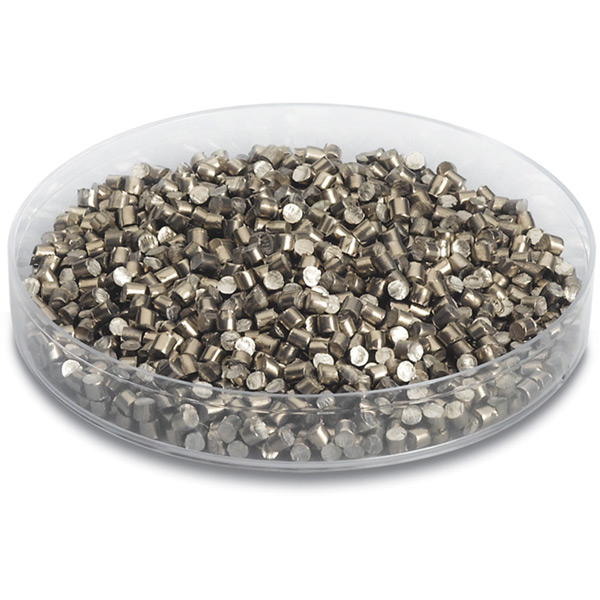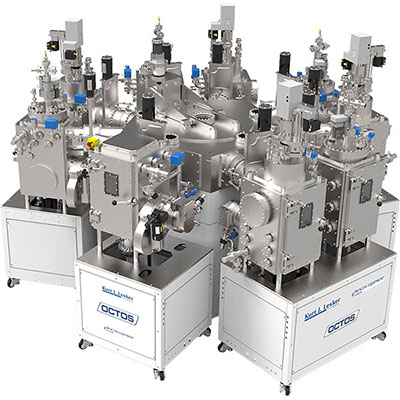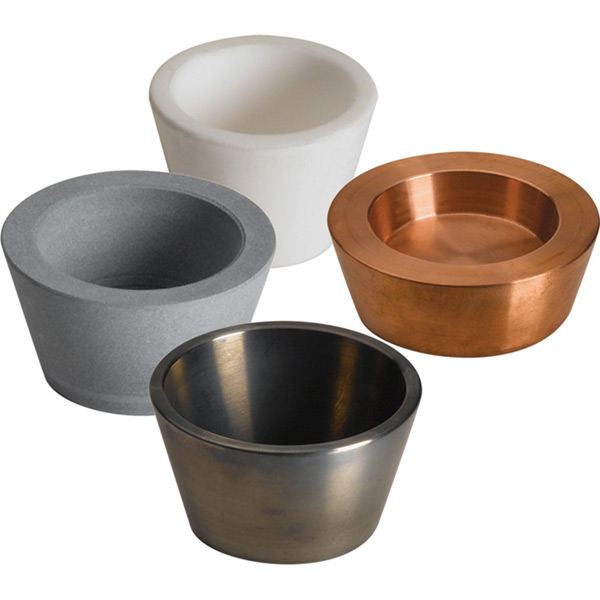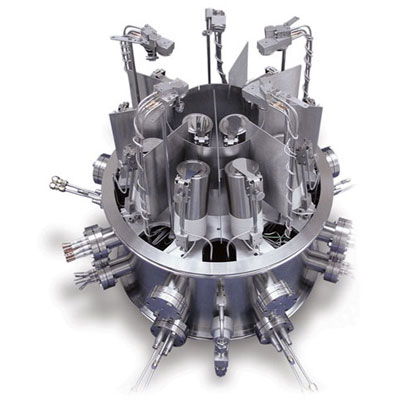Zirconium (Zr) Pellets Overview
We sell these pellets and pieces by unit weight for evaporation use in deposition processes. These approximate materials prices are published to provide budgetary guidelines. Actual prices can vary and may be higher or lower, as determined by availability and market fluctuations. To speak to someone directly about current pricing, please click here .
Zirconium (Zr) General Information
Zirconium is a classified as a transition metal on the Periodic Table. It has a density of 6.49 g/cc, a melting point of 1,852°C, and a vapor pressure of 10-4 Torr at 1,987°C. It is silvery-white in appearance and its propensity for corrosion resistance makes it heavily used by the chemical industry. Zirconium can be found in surgical appliances, superconductive magnets, and the cladding of nuclear reactors. It is also utilized as an alloying agent for steel. Its compound, zirconia, is often a substitute for diamonds in jewelry. Zirconium, along with its alloys and compounds, is evaporated under vacuum for optical coatings, semiconductors, and data storage devices.
Zirconium (Zr) Specifications
| Material Type | Zirconium |
| Symbol | Zr |
| Atomic Weight | 91.224 |
| Atomic Number | 40 |
| Color/Appearance | Silvery White, Metallic |
| Thermal Conductivity | 22.7 W/m.K |
| Melting Point (°C) | 1,852 |
| Coefficient of Thermal Expansion | 5.7 x 10-6/K |
| Theoretical Density (g/cc) | 6.49 |
| Z Ratio | 0.6 |
| E-Beam | Excellent |
| Thermal Evaporation Techniques |
Boat: W |
| Temp. (°C) for Given Vap. Press. (Torr) |
10-8: 1,477 10-6: 1,702 10-4: 1,987 |
| Export Control (ECCN) | 1C234 |
| Comments | Alloys with W. Films oxidize readily. |
| Suggested QCM Crystal | Alloy Crystal: 750-1002-G10**** |
**** Suggestion based on previous experience but could vary by process. Contact local KJLC Sales Manager for further information
Empirical Determination of Z-Factor
Unfortunately, Z Factor and Shear Modulus are not readily available for many materials. In this case, the Z-Factor can also be determined empirically using the following method:
- Deposit material until Crystal Life is near 50%, or near the end of life, whichever is sooner.
- Place a new substrate adjacent to the used quartz sensor.
- Set QCM Density to the calibrated value; Tooling to 100%
- Zero thickness
- Deposit approximately 1000 to 5000 A of material on the substrate.
- Use a profilometer or interferometer to measure the actual substrate film thickness.
- Adjust the Z Factor of the instrument until the correct thickness reading is shown.
Another alternative is to change crystals frequently and ignore the error. The graph below shows the % Error in Rate/Thickness from using the wrong Z Factor. For a crystal with 90% life, the error is negligible for even large errors in the programmed versus actual Z Factor.

Thermal Evaporation of Zirconium (Zr)
Zirconium requires a temperature of over 2,600°C for effective deposition as a thin film. Due to this high temperature requirement, it is nearly impossible to evaporate by thermal, resistive heating. Even if one is using a tungsten boat, there is a risk that the tungsten itself would begin to evaporate in the ppm contaminant levels. For this reason, e-beam evaporation or magnetron sputtering are the recommended methods for zirconium deposition.
E-beam Evaporation of Zirconium (Zr)
Zirconium is rated 'excellent' for e-beam evaporation. As of right now, we have not yet qualified a crucible liner material for e-beam evaporating zirconium and generally recommend to start with a FABMATE® liner since it is compatible with most materials.
Zirconium requires high powers in order to achieve an effective deposition rate. Typically, zirconium does not melt well to form a solid slug for evaporation. In other words, if the starting material is in pellet form, there is a high risk that even at high powers (>5kW), the pellets will not melt together uniformly which will increase the likelihood of the e-beam burning through the pellets and hitting the crucible. This can be evidenced by a sudden and steep fall-off of the deposition rate. It is then possible for the e-beam to drill a hole through the crucible liner and into the e-gun hearth. For these reasons, the e-beam evaporation of zirconium should be closely monitored through welder's shade 9 glass. Great care should be taken during the entire evaporation cycle due to the high degree of difficulty and risk of equipment damage.
A pre-machined slug (or starter source) is preferred over pellets. The two main benefits of using a starter source are ease of use and handling as well as superior packing density. Zirconium will still require high power for evaporation even when using a starter source, but less so than when using pellets. KJLC® can produce these starter sources. Contact us by clicking here with your e-gun manufacturer, pocket size, and number of pockets in order for us to produce a quote.
A key process note is to consider the fill volume of the crucible liner. We find that the melt level of a material in the crucible directly affects the success of the crucible liner. Overfilling the crucible will cause the material to spill over and create an electrical short between the liner and the hearth. The outcome is cracking in the crucible liner. This is the most common cause of crucible liner failure. Placing too little material in the liner or evaporating too much material before refilling can be detrimental to the process as well. When the melt level is below 30%, the e-beam is likely to strike the bottom or walls of the crucible which immediately results in breakage. Our recommendation is to fill the crucible between 2/3 and 3/4 full to prevent these difficulties.
Crucible liners should be stored in a cool, dry place and always handled with gloves or forceps.
See highlighted results that match your result in the table below.
Ordering Table
| More Info | Material | Description | Size | Quantity | Purity | Part Number | Price | In Stock | Add To Cart |
|---|---|---|---|---|---|---|---|---|---|
| More Info | Material | Description | Size | Quantity | Purity | Part Number | Price | In Stock | Add To Cart |
| Zirconium |
EUDF ZIRCONIUM PELLETS, |
1/4" Dia. x 1/4" Length | 1 lb. | Grade 702 | EVMZR30QXQ | $380.00 |
|
||
| Zirconium |
EUDF ZIRCONIUM PELLETS, |
1/4" Dia. x 1/4" Length | 25 g | Grade 702 | EVMZR30QXQA | $50.00 |
|
||
| Zirconium |
EUDF ZIRCONIUM PELLETS, |
1/4" Dia. x 1/4" Length | 50 g | Grade 702 | EVMZR30QXQB | P.O.R. |
|
||
| Zirconium |
EUDF ZIRCONIUM PELLETS, |
1/4" Dia. x 1/4" Length | 100 g | Grade 702 | EVMZR30QXQD | $108.00 |
|
||
| Zirconium |
EUDF ZIRCONIUM PELLETS, |
1/8" Dia. x 1/8" Length | 1 lb. | Grade 702 | EVMZR30EXE | $741.00 |
|
||
| Zirconium |
EUDF ZIRCONIUM PELLETS, |
1/8" Dia. x 1/8" Length | 25 g | Grade 702 | EVMZR30EXEA | $75.00 |
|
||
| Zirconium |
EUDF ZIRCONIUM PELLETS, |
1/8" Dia. x 1/8" Length | 50 g | Grade 702 | EVMZR30EXEB | P.O.R. |
|
||
| Zirconium |
EUDF ZIRCONIUM PELLETS, |
1/8" Dia. x 1/8" Length | 100 g | Grade 702 | EVMZR30EXED | $205.00 |
|
||
| Zirconium |
EUDF ZIRCONIUM PELLETS, |
1/8" Dia. x 1/8" Length | 1 kg | Grade 702 | EVMZR30EXEKG | P.O.R. |
|










